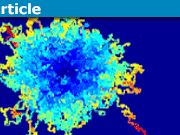How to Determine the Change in Entropy
How do you determine the change in entropy for a closed system that is subjected to an irreversible process?
Here are some typical questions we get at Physics Forums from confused members:
- If I have an irreversible adiabatic process, shouldn’t the change in entropy be zero since q/T is zero?
- Since entropy is a function of the state, shouldn’t the change in entropy for an irreversible adiabatic process between an initial and final equilibrium state be the same as that for a reversible adiabatic process between the same two thermodynamic equilibrium states?
My objective in this article is to offer my cookbook recipe for determining the change in entropy for an irreversible process on a closed system, and then to provide a few examples of how this recipe can be applied.
Table of Contents
THE ENTROPY CHANGE RECIPE
- Apply the First Law of Thermodynamics to the irreversible process to determine the final thermodynamic equilibrium state of the system
- Totally forget about the actual irreversible process (entirely), and focus instead exclusively on the initial and final thermodynamic equilibrium states. This is the most important step.
- Devise a reversible path between the same two thermodynamic equilibrium states (endpoints). This reversible path does not have to bear any resemblance whatsoever to the actual irreversible process path. For example, even if the actual irreversible process is adiabatic, the reversible path you devise does not have to be adiabatic. You can even separate various parts of the system from one another, and subject each of them to a different reversible path, as long as they all end up in their correct final states. Plus, there is an infinite number of reversible process paths that can take you from the initial state to the final state, and they will all give exactly the same value for the change in entropy. So try to devise a path that is simple to work with (i.e., for which it is easy to apply step 4).
- For the selected reversible path, evaluate the integral of dq/T from the initial state to the final state, where dq is the incremental amount of heat added to the system along the sequence of changes comprising the reversible path. This will be your change of entropy S. That is, ##\Delta S=\int\frac{dq_{rev}}{T}##, where the subscript rev refers to the reversible path.
EXAMPLE 1 Thermal Equilibration of Two Solids in Contact
Consider two identical solid objects, each of mass M and heat capacity C. Initially, the two solids are at temperatures ##T_H## and ##T_C##. The objects are then brought into thermal contact and allowed to spontaneously equilibrate.
Step 1: Apply the First Law of Thermodynamics to establish the final equilibrium state
There is no heat transferred and no work done on the combined system of two objects. Therefore, the change in internal energy of the system ##\Delta U## is equal to zero:$$\Delta U=CM(T_F-T_H)+CM(T_F-T_C)=0$$where ##T_F## is the final equilibrium temperature. Solving for ##T_F## gives:$$T_F=\frac{(T_H+T_C)}{2}$$
Step 2: Focus exclusively on the initial and final thermodynamic equilibrium states of the system.
State 1: Object 1 at ##T_H##. Object 2 at ##T_C##
State 2: Objects 1 and 2 at ##(T_h+T_C)/2##.
Step 3: Devise a reversible process to take the system from its initial to its final thermodynamic equilibrium state.
Starting from State 1, we first separate the two objects. We then take Object 1 and contact it with a continuous sequence of constant temperature reservoirs, running (very gradually) from its initial temperature ##T_H## to its final temperature ##(T_h+T_C)/2##. Similarly, for Object 2, we contact it with a continuous sequence of constant temperature reservoirs, running (very gradually) from its initial temperature ##T_C## to its final temperature ##(T_h+T_C)/2##.
Step 4: For the selected reversible path, evaluate the integral of dq/T from the initial state to the final state. This will be the change of entropy.
For the very gradual removal of heat from the hotter object along the identified reversible path, we have $$dS_1=\frac{dq}{T}=\frac{MCdT}{T}$$Integrating this equation between the initial and final states of Object 1, we obtain:$$\Delta S_1=MC\ln{\frac{(T_H+T_C)}{2T_H}}$$Similarly, for Object 2, we have:$$\Delta S_2=MC\ln{\frac{(T_H+T_C)}{2T_C}}$$So, if we add the changes in the entropies of the two objects together, we obtain the overall change in entropy of the combined system:$$\Delta S=2MC\ln{\left[\frac{(T_H+T_C)/2}{\sqrt{T_HT_C}}\right]}$$Note that the term in brackets in this equation is the arithmetic mean of the two initial temperatures divided by their geometric mean. Mathematically, this ratio is always > 1, so the natural log of the ratio is >0, and the entropy change for our spontaneous thermal equilibration process is positive.
EXAMPLE 2 Adiabatic Irreversible Expansion of an Ideal Gas
Consider the irreversible expansion of ideal gas in an adiabatic cylinder with a massless, frictionless piston. The volume, pressure, and temperature of the gas are initially ##V_0##, ##P_0##, and ##T_0##, respectively. ##P_0## is also the pressure applied externally to the piston in the initial state of the system: ##P_{ext}=P_0##. At a certain instant of time, we suddenly decrease the force per unit area applied externally to the piston to a (significantly lower) new value ##P_{ext}=P_F## and cause it to stay at this new value until the system re-equilibrates. In this scenario, the gas will expand very rapidly and irreversibly to the final state.
Step 1: Apply the First Law of Thermodynamics to establish the final equilibrium state of the system.
For an ideal gas, the First Law equation on this system reduces to:$$\Delta U=nC_v(T_F-T_0)=-P_F(V_F-V_0)\tag{1}$$where n is the number of moles of gas, ##C_v## is its heat capacity at constant volume, and the subscript F refers to the final thermodynamic equilibrium state. From the ideal gas law, $$V_0=\frac{nRT_0}{P_0}\tag{2}$$and $$V_F=\frac{nRT_F}{P_F}\tag{3}$$If we substitute Eqns. 2 and 3 into Eqn. 1, we obtain:$$C_v(T_F-T_0)=-R\left(T_F-\frac{P_F}{P_0}T_0\right)\tag{4}$$The solution to this equation for the final temperature is given by:$$T_F=\left[1-\frac{(\gamma -1)}{\gamma}\frac{(P_0-P_F)}{P_0}\right]T_0\tag{5}$$where $$\gamma=\frac{C_p}{C_v}=\frac{(C_v+R)}{C_v}\tag{6}$$The final volume can be determined by applying the ideal gas law:$$V_F=\frac{P_0}{P_F}\frac{T_F}{T_0}V_0=\frac{P_0}{P_F}\left[1-\frac{(\gamma -1)}{\gamma}\frac{(P_0-P_F)}{P_0}\right]V_0\tag{7}$$
Step 2: Focus exclusively on the initial and final thermodynamic equilibrium states of the system.
State 1: Ideal gas at ##P_0##, ##T_0##, and ##V_0##
State 2: Ideal gas at ##P_F##, ##T=T_F=\left[1-\frac{(\gamma -1)}{\gamma}\frac{(P_0-P_F)}{P_0}\right]T_0##, and ##V=V_F=\frac{P_0}{P_F}\left[1-\frac{(\gamma -1)}{\gamma}\frac{(P_0-P_F)}{P_0}\right]V_0##
Step 3: Devise a reversible process to take the system from its initial to its final thermodynamic equilibrium state.
Starting from State 1, reversibly change the temperature of the gas at constant volume ##V_0## from the initial temperature ##T_0## to the final temperature ##T_F##. This can be accomplished using the same kind of approach employed to change the temperatures of the objects in Example 1. For this reversible change, we have $$dU=nC_vdT=dq_{rev}$$.
Once the gas is at volume ##V_0## and temperature ##T_F##, expand the gas isothermally and reversibly to the new volume ##V_F##. This can be accomplished by very gradually reducing the pressure on the piston (while simultaneously adding heat from a constant temperature bath to maintain the temperature at ##T_F##) until the final volume ##V_F## is attained. During this second portion of the reversible process scheme, dU = 0, and $$dq_{rev}=dW=PdV=\frac{nRT_F}{V}dV$$
Step 4: For the selected reversible path, evaluate the integral of dq/T from the initial state to the final state. This will be the change of entropy.
If we evaluate the integral of dq/T for the combination of reversible process changes described in Step 3, we obtain:$$\Delta S=nC_v\ln (T_F/T_0)+nR\ln (V_F/V_0)\tag{8}$$Substitution of Eqns. 2-7 into Eqn. 8 enables us to express ##\Delta S## solely in terms of the initial conditions and the ratio of the final pressure to the initial pressure ##P_F/P_0## (after considerable mathematical manipulation):$$\frac{T_0\Delta S}{P_0V_0}=\frac{\gamma}{(\gamma-1)}\ln{\left[1-\frac{(\gamma -1)}{\gamma}\frac{(P_0-P_F)}{P_0}\right]}-\ln{\left[1-\frac{(P_0-P_F)}{P_0}\right]}\tag{9}$$The entropy change calculated from Eqn. 9 for our irreversible process is found to always be positive, irrespective of whether ##P_F<P_0## or whether ##P_F>P_0##. Therefore, the equation applies not only to irreversible expansions but also to irreversible compressions. We can get a better feel for how this plays out if we expand the right hand side of Eqn. 9 in a Taylor series in ##\frac{(P_0-P_F)}{P_0}##. The linear term in the expansion cancels out, and the first non-zero term is the quadratic term:$$\frac{T_0\Delta S}{P_0V_0}\approx \frac{1}{2\gamma}\left[\frac{(P_0-P_F)}{P_0}\right]^2+…\tag{10}$$The term in brackets in Eqn. 10 is positive definite irrespective of the values of ##P_0## and ##P_F##.
EXAMPLE 3 Gas and Vacuum in Divided Chamber
Consider a rigid insulated chamber of volume ##2V_0## divided in half with a barrier. In one-half the chamber there is an ideal gas at temperature ##T_0## and pressure ##P_0##. In the other half of the chamber, there is a vacuum. Suddenly, the barrier is removed, and the system is allowed to spontaneously re-equilibrate.
Step 1: Apply the First Law of Thermodynamics to establish the final equilibrium state
Since the chamber is rigid and insulated, no work W is done on the contents and no heat Q is transferred to the contents. So, from the First Law of Thermodynamics, $$\Delta U=nC_v(T_F-T_0)=0$$This means that the final temperature of the gas ##T_F## is equal to its initial temperature ##T_0##.$$T_F=T_0$$From the ideal gas law it follows that, since the volume has doubled, the pressure has halved: $$P_F=P_0/2$$
Step 2: Focus exclusively on the initial and final thermodynamic equilibrium states of the system.
State 1: Ideal gas at ##P_0##, ##V_0##, and ##T_0##
State 2: Ideal gas at ##P_0/2##, ##2V_0##, and ##T_0##
Step 3: Devise a reversible process to take the system from its initial to its final thermodynamic equilibrium state.
Remove the initial gas from the rigid, insulated chamber, and place it in a cylinder of the same initial volume featuring a massless frictionless piston. Cause the gas to expand isothermally and reversibly by placing the cylinder in contact with a constant temperature bath at ##T_0##, and moving the piston outward very gradually until the final volume is ##2V_0##. In this isothermal reversible expansion, dU=0, and $$dq_{rev}=PdV=\frac{nRT_0}{V}dV$$
Step 4: For the selected reversible path, evaluate the integral of dq/T from the initial state to the final state. This will be the change of entropy.
If we evaluate the integral of dq/T for the reversible process described in Step 3, we obtain: $$\Delta S=nR\ln(V_F/V_0)=nR\ln(2)=\frac{P_0V_0}{T_0}\ln(2)$$This entropy change is, of course, >0.
Read my next article: Lessons from the Bizarro Universe
PhD Chemical Engineer
Retired after 35 years experience in industry
Physics Forums Mentor








this article alone was sufficient to get my thermodynamics right.
[QUOTE="Chestermiller, post: 5614358, member: 345636"]Isolated systems are a subset of closed systems.[/QUOTE]I've thought that this could be the motivation. Thanks for your confirm!
[QUOTE="Lo Scrondo, post: 5614327, member: 608182"]Many thanks for your contribution Chet, I've read many useful answers you gave here, before signing in!If I just could ask a thing…Your insight talks about entropy change in closed systems. However, doesn't the last example depict an isolated system?[/QUOTE]Isolated systems are a subset of closed systems.
Many thanks for your contribution Chet, I've read many useful answers you gave here, before signing in!If I just could ask a thing…Your insight talks about entropy change in closed systems. However, doesn't the last two examples depict isolated systems?
You're the best, Chet!
[QUOTE="boneh3ad, post: 5548974, member: 268837"]Don't be so hard on yourself. I always thought of you more like the crazy old uncle.[/QUOTE]I don't know about the uncle part, but….
Thank you Chet! I am a Master student in thermal engineering and I find this extremely helpful. [emoji4]
Don't be so hard on yourself. I always thought of you more like the crazy old uncle.
Great recipe Chet! Looking forward to future tastings :)